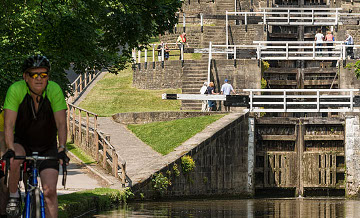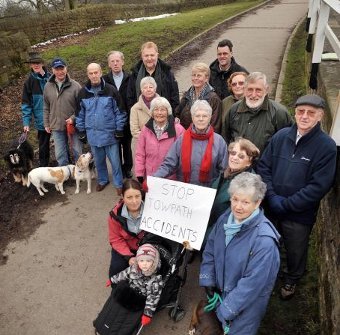THE push for cyclists to take over our towpaths continues apace with the latest high speed section highlighted in (Just under half million for L&L) with the towpaths now starting to become dangerous places to be, especially if you are on foot, writes Mick Fitzgibbons.
As the Trust is pressing for visitor numbers to increase, it begs the question at what cost?
Conflict with cyclists
It is logical that as visitor numbers increase, there is bound to be an increase in the number of reported incidents. Especially where people on foot are going to come into conflict with cyclists who are habitually travelling at high speed. As there is no set speed limit for the towpath, cyclists can proceed at any pace they see fit. But while there are no speed limits on the towpath, there are speed limits in many other places such as parkland where public and cyclists are expected to share the same space.
There are sections of the towpath which from my own experience are certainly not places where I would advise people with dogs or parents with children to frequent. And certainly not without both being on a leash or restricted by child reigns for their safety. I know, you know, even CaRT knows that accidents are occurring. Over the last few boating seasons we have been involved in several incidents involving cyclist travelling far too fast for their or our safety.
 Bingley
Bingley
I was involved in an incident on the Bingley Five Rise with a cyclist coming down the steep towpath at high speed. (More accidents waiting to happen). The cyclist scraped between myself and the boat as I was handling the mooring ropes. I reported the near miss to CaRT by telephone. I heard nothing further.
 I and two other boaters reported by telephone and followed up with an email an incident in Nottingham where the paved section of the towpath is in reality a high speed carriageway. I asked if someone from the Trust would come along and assess what was a dangerous situation where adults, dogs and children were coming into conflict with cyclists. (The picture shows a group of people complaining of the danger of high speed cyclists.)
I and two other boaters reported by telephone and followed up with an email an incident in Nottingham where the paved section of the towpath is in reality a high speed carriageway. I asked if someone from the Trust would come along and assess what was a dangerous situation where adults, dogs and children were coming into conflict with cyclists. (The picture shows a group of people complaining of the danger of high speed cyclists.)
"It's dangerous stood here."
Needless to say, no one came—in a classic case of 'bury you head in the sand'—the Trust ignored the situation. Later I also reported a boat being vandalised, resulting in three people being arrested. The next morning we had a visit from the police and while we were chatting, cyclists were passing by at high speed so close you could feel the air disturbance—the police officer summed it up in a few seconds when he said: "It's dangerous stood here.".
You may also remember the incident on the Chesterfield canal (Diabolical CaRT emergency service) where we came across a member of the public suffering from hypothermia and unable to move. We contacted the ambulance and police direct. Then we and ambulance service tried to contact CaRT via their emergency number, as access was needed through an emergency gate on the towpath. This was a complete shambles.
Incidents along the Cut
We had to render first-aid and summon the emergency services to a cyclist on the Leeds & Liverpool Canal who had fallen from his bike. (A Leeds & Liverpool adventure) He had broken his shoulder and collar bone. He was drifting in and out of consciousness. His friends had to be stopped from trying to pick him up. I also reported that one to the Trust.
A cyclist travelling at high speed along the Cut in Nottingham had to swerve to avoid a member of the public. (Towpath Velodrome) Hitting a mooring ring and then being thrown from his bike. Just missing our boat windows. We had to untangle him from his bike so that he could get up. A few moments later the rest of the group turned up including the lads father who said: "Now will you slow down? Not much good passing the cycling proficiency test. I might not be able to keep up, but at least I ride safer." The group departed again at high speed.
